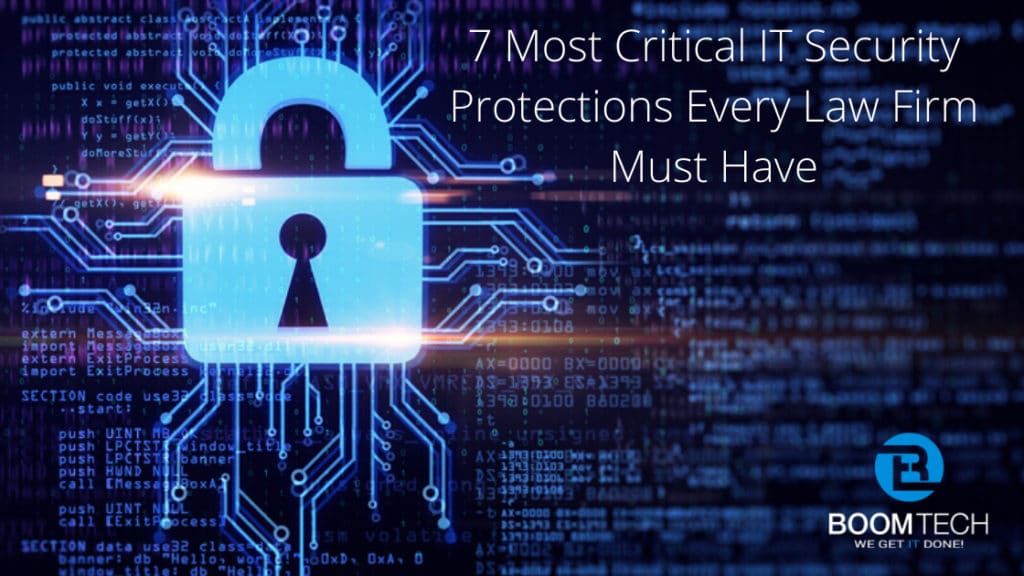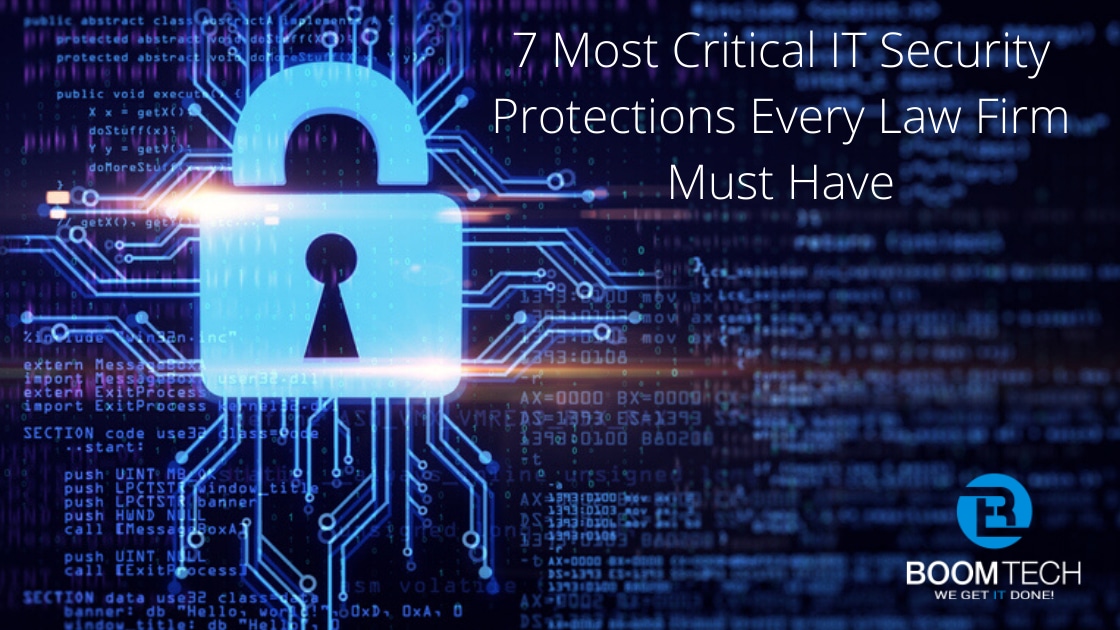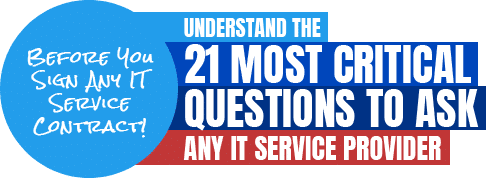
The 7 Most Critical IT Security Protections Every Law Firm Must Have In Place Now To Protect Themselves From Cybercrime, Data Breaches And Hacker Attacks
You, the managing partner of a small to a medium-sized law firm, are under attack. Right now, extremely dangerous and well-funded cybercrime rings in China, Russia, and the Ukraine are using sophisticated software systems to hack into thousands of small businesses like yours to steal credit cards, client information, and swindle money directly out of your bank account. Some are even being funded by their government to attack American businesses.

Don’t think you’re in danger because you’re “small” and not a big target like J.P. Morgan or Home Depot? Think again. One million NEW malware threats are being released every single day, and HALF of the cyber-attacks occurring are aimed at small businesses; you just don’t hear about it because it’s kept quiet for fear of attracting bad PR, lawsuits, data-breach fines – not to mention, sheer embarrassment.
The National Cyber Security Alliance reports that one in five small businesses have been victims of cybercrime in the last year – and that number is increasing as more companies utilize cloud computing and mobile devices, and store more information online. You can’t turn on the TV or read a newspaper without learning about the latest online data breach, and government fines and regulatory agencies are growing in number and severity. Because of all of this, you must have these seven security measures in place.
The #1 Security Threat To ANY Law Firm Is… You! Like it or not, almost all business world security breaches are due to an employee clicking, downloading or opening an infected file, either on a web site or in an e-mail; once a hacker gains entry, they use that person’s e-mail and/or access to infect all the other PCs on the network. Phishing e-mails (e-mails cleverly designed to look like legitimate messages from a web site or vendor you trust) are still a widespread occurrence – and spam filtering and anti-virus software cannot protect your network if an employee is clicking on and downloading the virus. That’s why you must educate all of your employees on how to spot an infected e-mail or online scam. Cybercriminals are EXTREMELY talented and can dupe even sophisticated computer users. All it takes is one slip-up, which is why constantly reminding and educating your employees is critical.
On that same theme, the next step is to implement an Acceptable Use Policy (AUP). An AUP outlines how employees are permitted to use company-owned PCs, devices, software, Internet access, and e-mail. We strongly recommend putting a policy in place that limits the web sites employees can access with work devices and Internet connectivity. Furthermore, you have to enforce your policy with content-filtering software and firewalls. We can easily set up permissions and rules that will regulate what web sites your employees access and what they do online during company hours and with company-owned devices, giving certain users more “freedom” than others.
Having this type of policy is particularly important if your employees are using their devices and home computers to access company e-mail and data. With so many applications in the cloud, an employee can access a critical app from any device with a browser, which exposes you considerably.
If an employee is logging into critical company cloud apps through an infected or unprotected, unmonitored device, it can be a gateway for a hacker to enter YOUR network – which is why we don’t recommend that you allow employees to work remotely or from home via their devices.
Second, if that employee leaves, are you allowed to erase company data from their phone or personal laptop? If their phone is lost or stolen, are you permitted to remotely wipe the device – which would delete all of that employee’s photos, videos, texts, etc. – to ensure YOUR clients’ information isn’t compromised?
Furthermore, if the data in your organization is highly sensitive, such as patient records, credit card information, financial information and the like, you may not be legally permitted to allow employees to access it on devices that are not secured; but that doesn’t mean an employee might not innocently “take work home.” If it’s a company-owned device, you need to detail what an employee can and cannot do with that device, including “rooting” or “jailbreaking” the device to circumvent security mechanisms you put in place.
- Implement The CIS 20 Critical Security Controls. The Center for Internet Security provides the 20 Controls each law firm or small business should have in place. You need to align your law firm to those each quarter to make sure you are doing everything possible to protect your clients’ data. This includes having a proper inventory of your hardware and software, implementing data recovery capabilities in case you fall victim to a cyber-attack, and more – click on the link below for the full list. https://www.cisecurity.org/controls/cis-controls-list/.
- Security Assessment. Data Breach Liability Report. Quarterly scans. Complexity is the enemy of security. A combination of scanning technology with advanced analytics makes for an ideal single go-to solution.
How Does It Work?
- Step 1: Triple-Threat Detection – The first step is to discover the unprotected data on a network, along with vulnerabilities and access permissions.
- Step 2: Data Breach Liability Report – Each quarter, we will review the potential risk and cost associated with that risk in the event of a data breach.
- Step 3: Risk Review – After discovering the risk, we can now analyze and see if we can eliminate the risk. For example, often, files are getting saved to the network that don’t need to be. If we establish that we need to keep the files, we can set up a proper mission and security procedures as well as drive encryption to protect that data.
- Deploy a Next-Generation Endpoint Protection. Next-generation endpoint and server protection uses several layers of attack prevention, including behavior detection and machine learning, to stop attacks that other vendors simply can’t. It also provides unparalleled threat visibility at a minimum system impact. BoomTech recommends Webroot.
- External Vulnerability. A vulnerability scanner is a computer program designed to assess computers, computer systems, networks, and applications for weaknesses. They can be run either as part of vulnerability management by those tasked with protecting systems or by black hat attackers looking to gain unauthorized access. Enter the new era of threat prevention.
- Protect Your Bank Account. Did you know your company’s bank account doesn’t enjoy the same protections as a personal bank account? For example, if a hacker takes money from your business account, the bank is NOT responsible for getting your money back. (Don’t believe me? Ask your bank what their policy is on refunding money stolen from your account!) Many people think FDIC protects you from fraud; it doesn’t. It protects you from bank insolvency, NOT fraud.
So here are three things you can do to protect your bank account. First, set up e-mail alerts on your account, so you are notified any time money is withdrawn. The FASTER you catch fraudulent activity, the better your chances are of keeping your money. In most cases, fraudulent activity caught on the DAY it happens can be stopped. If you discover even 24 hours after it’s happened, you may be out of luck. That’s why you must monitor your account daily and contact the bank IMMEDIATELY if you see any suspicious activity.
Second, require YOUR signature and 2-factor authentications for any wire transfers. Also, set a written wire transfer policy for all employees that if wire instructions get changed via e-mail, they are to pick up the phone and call the bank to verify it came from them and not a hacker.
And finally, contact your bank and shut down any debit cards associated with that account. All of these steps will significantly improve the security of your accounts.
Keep your network and all devices patched and up to date. New vulnerabilities are frequently found in common software programs you are using, like Windows operating systems. I hope you are no longer using Windows 7, which reached the end of life as of 1/14/2020. Also, you have to patch your 3rd party applications such as Adobe, Flash, or QuickTime; therefore, it’s critical you patch and update your systems and applications when one becomes available. If you’re under a managed IT plan, this can all be automated for you, so you don’t have to worry about missing an important update.
Categories
Hear from Philipp Baumann, owner and founder of BoomTech:


